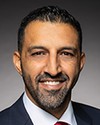Thank you for the question.
I believe the biggest problem that the buyers have is usually the deposit. Even though we try to make the deposits as small as possible, I think what is most important right now for us is to lower the deposit for so-called eco-homes as much as possible. With support from the different levels of the government, we can definitely do that.
One most gratifying development is the involvement of what I call institutional money. I believe that there are a lot of pension funds or institutional private equities that are now looking at the kind of energy assets we are building, not only in individual homes but also in condominiums. They are willing to come forward. They are saying, “Hey, Mr. Li, I want to support your geothermal initiative.” They will provide all the funding we need for the geothermal infrastructure; then what we need to do when we sell the condos is sign a contract with the condo owners so that instead of paying all the money up front, we can ask the condo buyers to pay a service charge, like $100 per month, so that in the next 25 years, they don't have to pay the utility. Instead, they pay me, the contractor, the fee for the use of the energy for the next 25 years.
This will help us to lower the sale price. This is a great help in making the buyers know that they are getting a home up front at a price that is comparable to prices from conventional builders. At the same time, they're only going to pay a limited service fee for energy over the next 25 years.
This is a big help. I can see that it's a very promising development.






